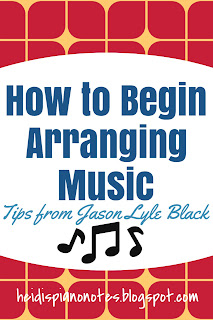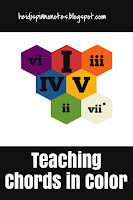Creativity involves breaking out of established patterns in order to look at things in a different way. - Edward de Bono
Inspiring my students with some Jason Lyle Black videos is just one of the many tools I have used to encourage my students to break away from the written page from time to time and try something different.After "wowing" us with a performance of Phantom of the Opera and John Williams Medleys, and some backwards piano, Jason instructed us on some basic ways for beginners to start arranging a hymn.
The audience chose "Hark the Herald Angels Sing" for the demo. I was amazed at his ability to recall the key and pull this 4 part harmony piece "out of thin air" without any music to aid him as he showed us samples of many different ways to arrange it. Fortunately, many of the ideas are easy enough for even younger piano students to implement.
1- ADD AN INTRO
- Repeat part of the verse an octave higher.
- Thin the texture by removing some notes from the tenor line to create a more open sound.
- Hold out the root note of the chord for the whole measure instead of using the written bass line.
- For more ideas on intros, check out Bradley Sowash's post on Easy Introductions.
2- VARY THE VERSES
- Drop the left hand an octave.
- Hold out the bass notes as suggested in the intro.
- Modulate to a different key. For example, change the key up a half step or whole step and create a bridge into the new key by holding out the Dominant chord of the key you are modulating to.
- Double the Bass Notes
- Repeat a piece of melody. Then add your own new insert as a bridge. Choosing a new key with chords that move only a small interval away works better. For example, when changing from C (CEG)to E Major (E G# B) the C moves down a whole step to B, E stays the same and G moves up a half step to G#
- Add some arpeggios or broken chords. Scale degree pattern of 135353 gives a lullaby feel.
- Spread out the arpeggiated chords by playing them open style. Instead of playing in root chord position, move the 3rd up an octave for a scale degree pattern of 1,5,10,5, 10, 5.
- Invert the chords to give a more tentative sound or feeling of anticipation. For example, play EGC instead of CEG.
- Substitute some of the chords for more variety. For example switch C Major to a minor. Chord substitution rules can be complex. Try switching to chords with common tones and use your ear as your guide. I start with a simplified approach to substituting by Teaching Piano with Chord Colors.
- Change the mood by swapping major for minor or minor for major. It is more effective to change back and forth from major to minor than just transposing an entire piece to the parallel minor (C Major to c minor). Changing moods evokes more emotion than just playing an entire "creepy" sounding Jingle Bells.
- For orchestral arranging include foreground, middle and background layers of the melody by selecting appropriate instruments. For example select the lead instrument (Piano/Horns Trumpet/Trombone), add echo parts in the middle (strings/woodwinds) and add percussion for the background. The possibilities are endless! GarageBand (included on most newer idevices) is a user-friendly option for students although Cubase is an alternative. This is a more complex area I have not explored much yet, but as Jason demonstrated layering and had us listen for the difference , it made me think of PhilTulga's free Unifix Drum cubes that my students enjoy using to create some fun percussive layering.
3-ENDING IT WELL
- Repeat the last phrase or line with a ritardando at the end.
- This tip brought to my mind another great source for ideas on endings : Bradley Sowash's post, Improvising Outros.
Disney Medleys
Beauty and the Beast
Throughout the workshop his effective thought-provoking question of "Can you hear the difference?" really helped me engage my ear to differentiate between the effects of different changes. I like to ask my students a similar question as we play the "What Changed?" Game with Theme and Variation Cards. See more about ways to inspire creativity in these related posts.
5 Fun Ways to Teach Theme and Variations Form in Music Lessons
Teaching Piano with Chord Colors
Composition 101: 5 Avenues to Begin Composing
Encouraging Improv with Jingle Bells Variations
Inspiring Creativity in Piano Lessons with 20 Variation Cards




No comments:
Post a Comment